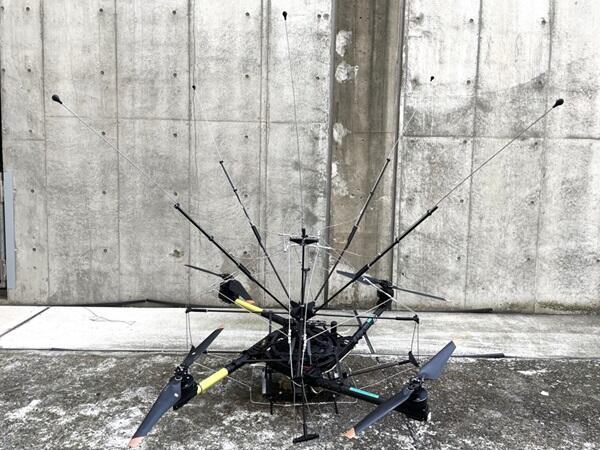NTT has successfully conducted experiments using drones to induce and guide lightning, for the first time in the world. The company demonstrated the effectiveness of lightning-resistant drone technology and lightning induction technology utilizing electric field fluctuations, marking progress toward realizing "flying lightning rods" that can protect cities and critical infrastructure.
Making lightning strike and guiding it with drones is not a simple task. This is because the drone must continue flying even after being struck by lightning, and merely flying a drone under thunderclouds is not enough to attract lightning—an active triggering method is required.
To address these challenges, NTT proposed and demonstrated two technologies. The first is lightning-resistant drone technology. The company devised a design method for a lightning-resistant cage with which commercially available drones can be equipped, preventing malfunction or failure even if they are directly struck by lightning.
The lightning-resistant cage is a metal shield that diverts the large electric current when lightning directly strikes the drone, preventing the lightning current from flowing into the drone itself. Additionally, by channeling the lightning current radially, the strong magnetic fields generated by the large current cancel each other out, reducing the magnetic field effects on the drone. Furthermore, artificial lightning application tests were conducted on drones equipped with the lightning-resistant cage. The tests confirmed that the drone would not malfunction or fail even when subjected to 150 kA of artificial lightning, which is five times the average value and covers more than 98% of natural lightning strikes.

Photo by courtesy of NTT
The second technology uses electric field fluctuations to induce lightning. In the method employed in this technology, a conductive wire connects the flying drone to the ground, with a high-voltage switch attached to the ground side. The electric field intensity around the drone is changed by using the switch to induce lightning.
By connecting the drone to the ground at an optimal time through the switch, the electric field intensity around the drone rapidly increases, successfully inducing lightning. The drone used in the experiment was a commercially available model measuring 2.3 meters wide (including propellers), 0.39 meters tall, and weighing 10.4 kilograms. The experiments were conducted from December last year to January this year at an elevation of 900 meters in a mountainous area of Hamada City, Shimane Prefecture.
Using a device called a field mill, the ground's electric field was observed, and when thunderclouds approached and the surrounding electric field intensity increased, the drone equipped with the specially developed lightning-resistant cage was flown to attempt lightning induction.
On December 13, when thunderclouds approached and the surrounding electric field intensity increased, the drone with the wire attached was flown to an altitude of 300 meters (1,200 meters above sea level), and the drone was connected to the ground using a switch installed on the ground.
As a result, a large current flowed through the wire, and simultaneously, a significant change in the surrounding electric field intensity was confirmed. Additionally, it was confirmed that a voltage of over 2,000 V was generated between the wire and the ground immediately before the lightning induction.
By rapidly changing the electric field intensity around the drone, lightning was induced by the drone, marking the world's first successful experiment using a drone to induce lightning. At the time of the lightning induction, a bursting sound, illumination at the winch section, and partial melting of the drone's lightning-resistant cage were observed. However, the drone equipped with the lightning-resistant cage continued to fly stably even after the lightning strike.
NTT plans to further advance research and development on high-precision lightning location prediction and lightning generation mechanisms to increase the success rate of drone-induced lightning demonstrated in this experiment.
There are challenges regarding the practical application of this "flying lightning rod" using drones, such as improving lightning induction efficiency, handling the wire, enhancing drone performance, and relaxing legal regulations on drone flights. As these are expected to take time, commercialization is anticipated around 2030.
Additionally, NTT aims to store and utilize the energy from induced lightning and will engage in research and development of lightning energy storage methods. Incidentally, there is a calculation that the power from a single lightning strike is approximately 400 kWh, equivalent to the monthly power consumption of an average Japanese household (family of four). Although the storage method is still in the research stage, since lightning generates a large current in a short time and cannot charge existing batteries, the company is considering energy conversion methods such as converting it to kinetic energy or compressed air.
This article has been translated by JST with permission from The Science News Ltd. (https://sci-news.co.jp/). Unauthorized reproduction of the article and photographs is prohibited.




